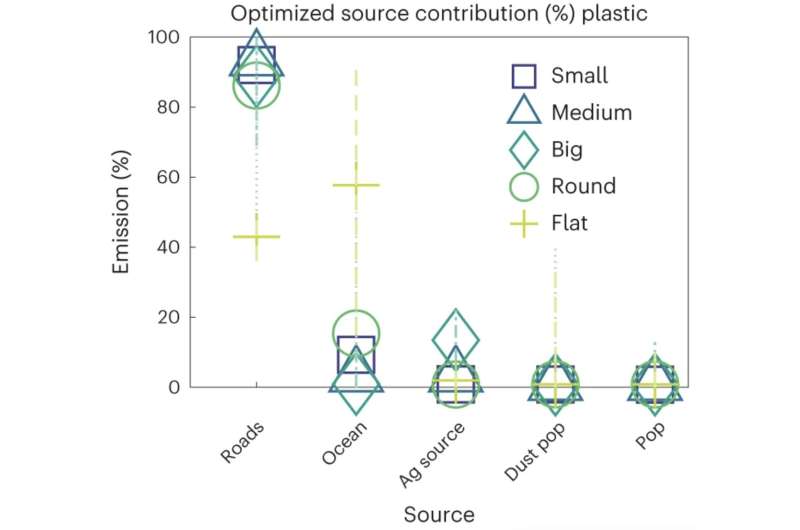Atmospheric microplastic transport predominantly derived from oceans, study finds

Microplastics in our natural environments are of increasing concern as these tiny particles (<5mm diameter) pollute ecosystems, posing issues to the well-being of animals and humans alike. There are two principal categories of microplastics: primary particles are manufactured for their size and originate from consumer products, such as the microbeads used in cosmetics, while secondary microplastics occur due to the breakdown of larger materials, such as plastic water bottles and matter from industrial waste.
This breakdown occurs due to ultraviolet radiation from the sun causing plastic to become brittle and thus susceptible to the erosive action of waves in particular to shear off flakes into the surrounding environment.
Their longevity during decomposition, taking upwards of 500 years to complete in a landfill, is a critical factor of their detrimental impact on habitats. Marine animals ingest microplastics suspended in the ocean, and microplastics mixed with the sand on our beaches is barely noticeable. Research has discovered microplastics in the smallest plankton all the way through to filter feeding giants of the sea—whales.
But it is not just the ocean that transports these tiny particles across the globe. Atmospheric wind regimes can carry microplastics vast distances, and their shape has a critical impact on airborne retention before deposition.
New research published in Nature Geoscience considers a theory-based model to determine the settling velocity (the point at which a particle stops being suspended in air and settles due to gravity) of microplastics of various sizes and shapes (up to 100μm long and down to 2μm wide), as compared to previous research that has assumed spherical microplastics. The effect of air turbulence on settling velocity was also factored to determine long distance transport.
Dr. Shuolin Xiao, of Cornell University in New York, and colleagues found that flatter microplastics had overestimates of their dry atmospheric deposition rate under the traditional spherical particle model compared to their newer model, as well as enhanced residence times in the environment >450%. Consequently, this research highlights that microplastics are likely to travel farther than previously thought through atmospheric wind regimes, and therefore deposit over a much larger area. However, by modeling their atmospheric transport it may be possible to determine source locations to aid management plans and reduce further dispersal.
The research team used experimental data on the settling of nylon fibers alongside the model and concluded that very thin and long microplastic fibers would be particularly abundant in both natural and urban environments, being deposited sooner and closer to the source and have greater longevity in ecosystems than spherical particles. The irregularity of air turbulence was found to impact elongated microplastic fibers more than spherical ones as it alters transport orientations and therefore settling velocity due to its weight and air resistance.
This model validates previous work published in Science by Dr. Janice Brahney, Associate Professor at Utah State University, and collaborators who had collected microplastic samples from national parks across the United States. Evaluating a total of 1,260 length and width measurements alongside microplastic fiber shapes, the team determined that these fibers, predominantly derived from clothing, contributed to more than 1,000 metric tons of microplastics deposited by wind and rain within the south and central western United States alone annually.

With this knowledge, the research team then considered a number of key sources of microplastics carried by atmospheric transport: particles from roads and tires, particles picked up by wind from the surface of the ocean, dust from agricultural practices (likely from the application of wastewater that contains microbeads from cosmetic and cleaning products) and urban activities, and the vast array derived from the population globally.
Based on the model, deposition of flat fibers from tires were reduced compared to previous models, while those derived from the ocean had increased. Dust from agriculture and urban activities as well as the overall anthropogenic sources in daily use was found to be less impactful. The exact mechanism by which microplastics in the ocean become airborne does however require further investigation, particularly as this appears to be a dominant source.
While some remote areas of the planet may be considered "pristine" and protected from direct human interaction, this research highlights that our fingerprints can still be found in far-reaching locations, and the toll of plastic consumption now will continue to be felt over generations to come if high-risk forms are not sufficiently managed.
More information: Shuolin Xiao et al, Long-distance atmospheric transport of microplastic fibres influenced by their shapes, Nature Geoscience (2023). DOI: 10.1038/s41561-023-01264-6
Journal information: Nature Geoscience , Science
© 2023 Science X NetworkScientists reveal the transportation mechanism of atmospheric microplastics
No comments:
Post a Comment